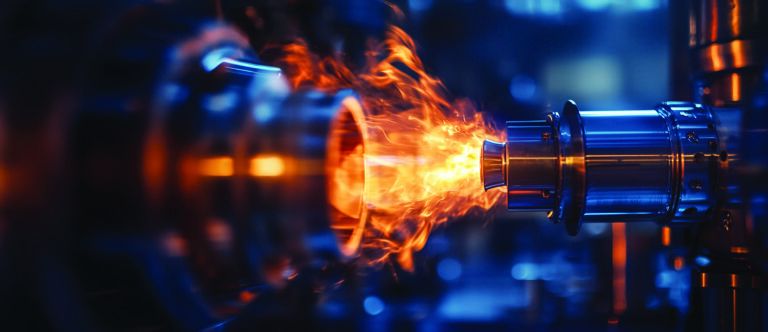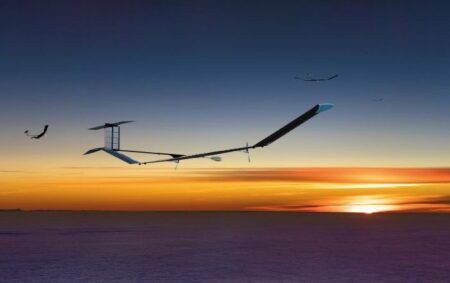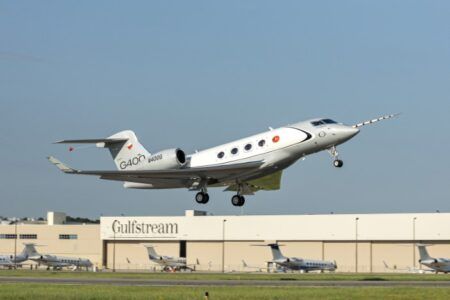There are several aerospike engines in development and testing around the world. For example, engineers at
Dubai-headquartered computational engineering company Leap 71 successfully test-fired their aerospike engine during December last year for four days.
The hot-firing took place at Airborne Engineering’s test site in Westcott, UK and produced 5,000N (1,100 lbf) of thrust, powered by cryogenic liquid oxygen and kerosene. According to Airborne the design for the engine was “generated autonomously by the latest generation of Noyron, its large computational engineering model.”
Leap 71 claims that AI was used to develop the thruster in a matter of weeks. The prototype was “manufactured as a monolithic piece of copper through industrial 3D printing, and put on the test stand, where it worked successfully on the first attempt.”
Traditionally, the design and testing and manufacturing of aero-engines takes many years – involving repeated modeling, testing, revision, prototyping and analysis to ensure that an engine is going to meet requirements. Leap 71 appears to have disrupted this model with its aerospike engine test. Leap 71’s successful test also puts it among a small group that over the last 30 years have mastered the complex challenges of the aerospike engine design, alongside teams from NASA, USA-based Stoke Space, India’s SpaceFields, Spain’s Pangea Aerospace and Germany-based Polaris Raumflugzeuge (Polaris Spaceplanes).
Disruptive rocket engines

Engineers at Pangea Aerospace claim to have “designed, manufactured and hot-fire tested the most disruptive rocket engine in the world,” solving the historical problems of the aerospike: cooling, weight, and manufacturing costs.
Working with the aim of reducing the environmental impact and cost of space launches, Pangea says its aerospike engine will increase the amount of payload put into orbit per launch and improve carbon neutrality and offers “a shorter time to market without investing into a complex and costly engine program”.
Achieving firsts is part of the race to develop aerospike engines. For example, Polaris recently went a step further when testing its aerospike engine – achieving the first flight of its MIRA II aircraft on October 29, 2024 from Peenemünde Airport, Germany over the Baltic Sea, around 3km (2 miles) from the ground station. The day began with a rolling tarmac test of engine before the test flight.
Using an autopiloted pre-determined flight path, the aircraft powered by its kerosene jet turbines took to the air before igniting its AS-1 LOX (liquid oxygen) kerosene linear aerospike rocket engine for three seconds – making it the first firing of a 1kN aerospike rocket engine in flight. Unlike Mira 1, it returned to their airport and landed safely after covering a distance of 10km (6 miles).
Aerospike feasibility
These projects and others show it is possible to design, test, and develop aerospike rocket engines. However, their development is not new. Kara Mohebian, the head of propulsion at Polaris says they have been studied since the 1950s as an alternative to traditional rocket nozzles. They are different to traditional rockets because they invert the bell-shaped rocket nozzles that have been commonly used in rocket designs for decades.
Mohebian explains: “Unlike bell-shaped nozzles, aerospikes adjust their exhaust flow based on external pressure, making them highly efficient across different altitudes.
“Early tests were conducted in the Cold War era, and significant development took place in the 1990s with various experimental programs.
“Although aerospikes are mainly designed for space applications, they have potential terrestrial uses, such as hypersonic aircraft. The main challenge has always been cooling and structural complexity, but recent advancements in materials and manufacturing are making their practical use more feasible.”
Lin Kayser, founder and CEO of Leap 71, adds that aerospikes were primarily developed by Rocketdyne and NASA as a more efficient alternative to traditional bell nozzles: “The key advantage is altitude compensation, maintaining high efficiency from ground level to the vacuum of space, which sets them apart from conventional thrusters.”
However, teams have struggled for many years to make aerospike engines work. The Space Shuttle was supposed to use aerospike engines, but engineers lacked the tools and the production methods at the time to make it happen. Subsequently, they couldn’t “overcome the challenges of that engine, most notably cooling
the spike, which sits in the middle of the exhaust gas,” says Kayser.
As for the advantages of aerospikes, Apurwa Masook, the founder and CEO of India-based propulsion-systems company SpaceFields, says they are most relevant for space applications, but that technical challenges and limited funding has disrupted their deployment. Masook says, “They are especially important for single-stage-to-orbit applications, but there are interesting applications in atmospheric flight for combined cycle engines in hypersonic aircraft”.
Additive manufacturing
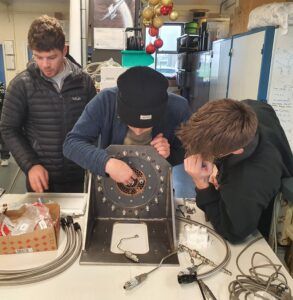
Alistair John, program lead for aerospace engineering at the University of Sheffield in the UK says the renewed interest in aerospikes is partly thanks to additive manufacturing, which allows for the parts to be made more easily. He adds that aerospikes are related to rotational engines, which have also captured the interest of NASA recently, and are related to them.
Aerospikes use atmospheric pressure to give optimal nozzle expansion, allowing them to maintain efficiency at different altitudes. Traditional rockets tackle this by having different stages and tend to have much larger nozzles. With aerospikes, it is possible to have a smaller nozzle and to have fewer moving parts for thrust vectoring. Yet they are hard to make because of the difficulties in keeping them cool and prevent them
from melting.
Additive manufacturing and computational engineering help to make the complex internal geometries of an aerospike engine cool. “With Leap 71’s software you can also iterate rapidly and make the geometries more easily, allowing you to remake and redesign parts quickly,” he says.
Faster design
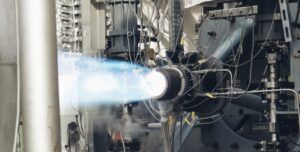
Advanced computational models make it easier to update a design, yet the key to that remains testing. Not everything can be done on a computer to find out whether an aerospike design works or not. Data from real-world testing allows for the modeling to be updated to be more accurate. “Software enables you to design the geometry, you use rapid prototyping, then test and get the data quickly, so you can begin the next iteration,” says John, who adds that computational engineering and AI can reduce the amount of manual CAD.
John also believes it is important to embed engineering experience into the model. This means that the process is not entirely hands-off. However, it is possible to code engineering knowledge into the software to capture it. This knowledge can then be incorporated into future design iterations of, for example, an aerospike engine.
Mohebian says, “Large-scale computational models are one of many tools in the propulsion development process, allowing engineers to simulate real-world conditions before building expensive prototypes, reducing testing costs and iterations. But simulation results must always be verified using other engineering methods.”
She says computational fluid dynamics (CFD) models are also essential for improving designs before real testing of flow thermal dynamics and thermal loads. The use of AI-driven CFD and Finite Element Analysis (FEA) simulations enables the further acceleration of iterative design loops.
Masook explains, “At SpaceFields, we train AI models on experimental data from Ballistic Evaluation Motors, strand burn tests, and cold flow testing with Schlieren imaging. We have developed an extensive in-house dataset comprising hundreds of test results, allowing us to fine-tune predictive models for enhanced accuracy in propellant performance characterization, failure detection, and engine optimization.”
A fundamental shift

Kayser describes computational engineering as a fundamental paradigm shift.
Most engineering projects work using a visual approach, “where their output is a drawing of the thing they envision.” Computational engineering moves this work to a software-driven approach, where you automate repetitive tasks and improve on previously encoded approaches through a collective team effort. This requires a new way of working that will be transformative for anyone who applies it consistently.
As for the prospects of aerospike engines themselves, Mohebian believes they are promising for next-generation propulsion systems. However, they do need to be thoroughly evaluated for safety, reliability, and performance. This will include subsystem testing, ground-based static firings to analyze thrust, cooling, as well as efficiency and
high-altitude test flights using experimental vehicles.
A combination of modern engineering techniques and rigorous real-world validation could enable aerospike engines to enter service as propulsion systems for spaceplanes. They offer valuable advantages for future space exploration and high-speed terrestrial propulsion systems. More than ever before aerospikes have a future – thanks to the advent of AI, machine learning and large computational engineering. But, much also depends on whether these programs can keep their investors happy. Without finance, nothing will fly.


